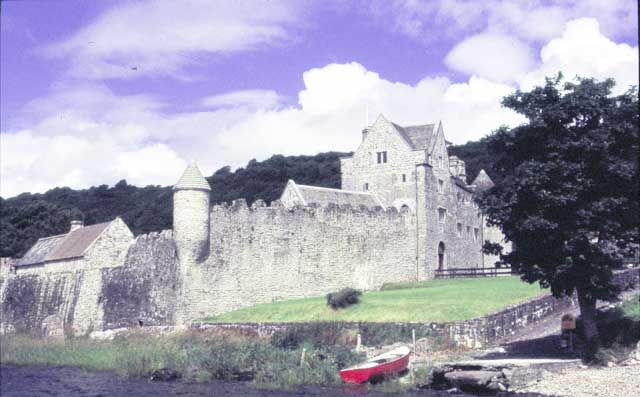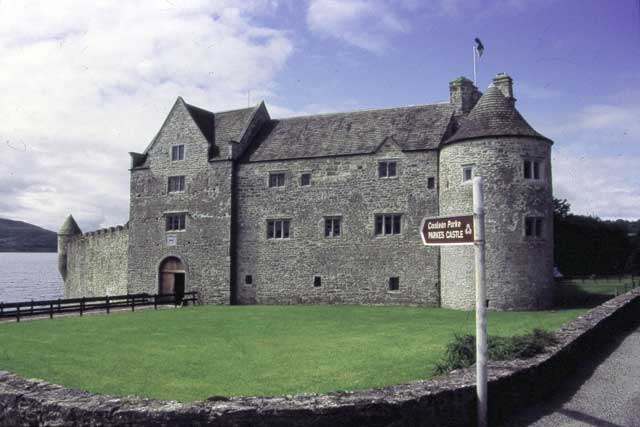Opening Hours
2nd April – 30th September: Daily 1000 – 1800
Pricing
Adult: €4
Senior: €3
Child: €2
Student: €2
Family:€10
Tours of Parkes Castle

Guided Tours are available on request.
Information leaflet, guidebooks are available in English, Irish, French, German, Italian, and Spanish
Tour last approximately 40 minutes
Last admission is 45 minutes before closing.
Parkes Castle Contact Information
Parkes Castle, Fivemile Bourne, Co. Leitrim
Telephone No: +353-71-9164149
Email: parkescastle@opw.ie
Facilities
Toilet facilities
Disabled toilet facilities
Parking at Parkes Castle
Parkes Cattle is situated along the enchanting and history saturated banks of Lough Gill in lush and beautiful Co. Leitrim. An epic multiphase Castle that encapsulates the sometimes violent history of Ireland.
This Castle is a magnificent example of a Plantation era Castle. Situated in what was the Ancient Kingdom of Breifne, one of the original Ancient Irish Kingdoms.
This area of Ireland is tied to some of history’s most important and legendry events. Parkes Castle is deeply tied to one of those events, The Plantations.
What were The Plantations of Ireland?
The Plantations refers to a period in Irish history when the English Crown confiscated vast areas of land in Ireland and settlers from Britain were planted onto these confiscated lands.
These Plantations mainly occurred during the 16th and 17th centuries. Ireland had undergone periods of settlement by Vikings and Normans but this was the first organized mass settlement of settlers on confiscated lands that had been held by the Irish or Hiberno Norman families for centuries.
There were several periods of Plantation in Ireland, the first notable Plantation was by the notorious King Henry VIII, these involved lands in the provinces of Munster and Leinster. Then again under Queen Mary I and Queen Elizabeth I. the daughters of King Henry VIII.
The most successful Plantation was that of King James I, this was the Plantation of Ulster, when the lands of powerful Irish Chiefs were taken into the possession of the Crown.
This usually occurred when the rebellious Irish Chiefs and Kings broke the terms of Surrender and Regrant.
There was also the confiscation of lands by Charles I and Oliver Cromwell, who famously said “to hell or to Connaught”. This meant that the people who owned vast areas of land in Ireland either had to give up their Catholic faith or lose their lands.
Cromwell dispatched thousands of Parliamentary British Solders to carry out these confiscations of land and to protect the interests of the new settlers.
Under the new regime the catholic ruling class were swiftly replaced by a new protestant ruling class who’s interests were closely tied to that of Britain, which lead to the creation of a new Protestant Ascendancy, which would hold power of government in Ireland.
Who were the O’Rourke’s of Parkes Castle?
The O’Rourke Family was a powerful Irish Clan that ruled the Irish Kingdom of Breifne which is now known as County Leitrim.
The famous Clan was though to have existed since approximately 870AD and ruled over their lands until the Plantations in the 17th Century. The family also held the titles of High Kings of Ireland. The first ruling member of the Clan is considered to by Ruarc Mac Tighearnan and the final ruler was Tadhg O’Rourke.
The name comes from the Norse background of the founding member, his Grandfather who was a Viking settler named Roderick.
In Irish O’Rourke means “Famous King”, referring to the famed kings of the Clan. The most famous O’Rourke was Brian O’Rourke, father of Brian and Tadgh the last leaders of the Clan.
O’Rourke was part of a famed rebellion, he was unhappy with British interference in his territories, he did not accept the terms of a peace treaty with the crown and he approached Scottish lords for help, bringing with him famed Irish Wolfhounds as gifts.
However this help was not granted and he was extradited to the Tower of London put on trial for for the crime of treason against the crown and executed. His friendship with the Spanish, the bitter enemies of the British and his involvement in the Nine Years War all contributed to his downfall, he is immortalized in The Annals of The Four Masters.
He remains one of the most famed characters in the fight against English Plantations and a leader of the Irish Forces during the Nine Years War that would see the era of Ancient Irish Kingdoms come to an end.
O’Rourke was succeeded by his Son Brian O’Rourke who was in turn succeeded by his brother Tadgh who was to be the last King of the Clan O’Rourke.
The History of Parkes Castle.
Parkes came into the possession of O’Rourke’s lands and property after it was confiscated by The Crown. Brian O’Rourke was executed in London for the crime of high treason against the crown in 1591.
The Plantation settlers brought with them there own architectural styles and Parkes Castle is possibly one of the best examples of this. Parkes Castle dominantly stands three stories high, giving it a panoramic view of the surrounding lands.
Although called a castle, Parkes Castle it is a wonderful example of a fortified manor house. It was famously the site of O’Rourke family castle; it was the site of their main seat of power and main residence in the earlier part of the 15th century.
The O’Rourke Castle was an Irish Castle or Tower House surrounded by a bawn or curtain wall. Parkes kept and used the original O’Rouke Bawn to protect his plantation style development, which replaced the original defensive structure of the O’Roukes.
The new 3 story manor would be surrounded and enclosed by the pentagonal defensive wall, where O’Rourke’s Irish tower house once stood emerged Parkes development with diamond shaped chimneys and mullion windows.
One of the bawn’s flanking towers was to become one end of the new manor and a new arched gateway was also added. The O’Rourke’s Tower house was unearthed during excavation of Parkes castle in the early 1970’s, it was found beneath the cobbled courtyard and its historic foundations are now on display to the public.
Parkes Castle was abandoned in the late 17th Century and sadly fell into a serious state of disrepair. The Irish Office of Public Works restored the Castle using traditional methods and materials. They extensively restored and conserved Parkes Castle for future generations.

